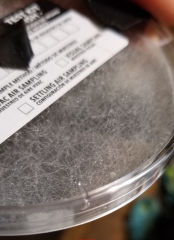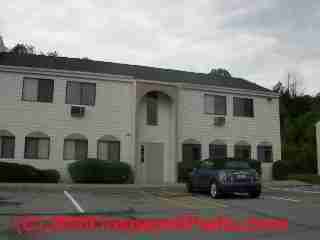 Unsafe or Unhealthy Apartment or Rental Home?
Unsafe or Unhealthy Apartment or Rental Home?
Advice to Renters
- POST a QUESTION or COMMENT about handling indoor hazards, air quality, contaminants, or mold problems in rental homes, apartments, mobile homes, doublewides
Mold and other indoor hazard or contamination advice for renters:
This article series discusses the steps that a tenant in a rental apartment or rental home can take to look for and test for mold, responding to other possible indoor contaminants or safety hazards, how to inform building management of a known or suspected building hazard or safety problem, what to expect the rental property managers to do if they are going to address a health or safety problem properly, and what the rental apartment tenant needs to watch out for during a mold investigation and mold remediation of their home.
InspectAPedia tolerates no conflicts of interest. We have no relationship with advertisers, products, or services discussed at this website.
- Daniel Friedman, Publisher/Editor/Author - See WHO ARE WE?
Advice for Rental Tenants - What to Do About an Unhealthy or Unsafe Home
 What can & should a renter or tenant do about an unsafe (for any reason) or a moldy apartment, rental home, trailer, or other living space. Advice about handling indoor hazards, air quality, contaminants, or mold problems in rental homes, apartments, mobile homes, doublewides.
What can & should a renter or tenant do about an unsafe (for any reason) or a moldy apartment, rental home, trailer, or other living space. Advice about handling indoor hazards, air quality, contaminants, or mold problems in rental homes, apartments, mobile homes, doublewides.
Watch Out: IF YOU SUSPECT CARBON MONOXIDE POISONING, GO INTO FRESH AIR IMMEDIATELY and get others out of the building, then call your fire department or emergency services for help.
Watch out: IF YOU SUSPECT SEWER GAS or METHANE GAS HAZARDS do not operate electrical switches, cell phones, or light any flame - there may be an explosion hazard. Get others out of the building, then call your fire department or emergency services for help. Sewer gas contains
methane gas (CH4) - a risk for an explosion hazard or even fatal asphyxiation.
List of Places to Get Help with an Unsafe Rental Home
If you need help in resolving a tenant-landlord dispute or if your landlord won't respond to un-safe or un-healthy conditions in your rental home, these are the usual places you would go for help:
- Your landlord
Before complaining to an outside agency be sure that you have notified your landlord, in writing, of the unsafe or unhealthy conditions in your home, and that you have given the landlord an opportunity to respond. - Your local department of health
If there is a serious and obvious problem with mold or other health concerns in a rental apartment, the health department may condemn the property and require the owners to act. In our opinion this is a rather drastic step though it may be appropriate in dire circumstances. See
HEALTH DEPARTMENT HELP for RENTERS - Your local building department
The building officials may agree to inspect your home and if it is unsafe the official may require the landlord to make necessary repairs. - Your local legal aid society
An attorney can help you navigate tenant-landlord disagreements or to require provision of safe, habitable housing. If you can not find a local legal aid service where you live, try the legal aid sources
at LEGAL AID ATTORNEY HELP SOURCES - Your local emergency housing authority
If your home is an immediate life-safety hazard, and if there is an emergency housing authority near you contact them to determine what housing is available, and when. - Local churches or synagogues
May be able to provide temporary housing or to assist by other means. - Local media or website publicity?
Some of our readers have contacted local newspapers or TV stations who, on interviewing the reader and seeing their living conditions, presented those conditions in local news media, prompting the landlord to take appropriate action
Other of our readers have posted photographs and descriptions of their living conditions along with the name and address of the property and of its owner, prompting the landlord to make necessary health and safety repairs.
What can a tenant do when s/he discovers that s/he is living in an intolerably moldy apartment?
Rental Unit Mold Contamination Guide: how to handle mold problems or other indoor air hazard conditions at a rental property - Mold & IAQ testing advice for rental tenants - what can a tenant do about a moldy apartment or rental home? & Mold testing and mold remediation advice for landlords.
Tenant's Action Guide to Indoor Contaminants, Hazards or Mold in Rental Homes, Apartments, Offices
A rental tenant in a moldy apartment in Kentucky asked us for advice. The risk in her situation was increased because she suffers from a compromised immune system. our advice to her follows her letter.
Tenant describes a moldy apartment
I appreciate the user friendly format and the wealth of information on your SICK HOUSE WEBSITE. I'm suffering severely from mold related illness and I need immediate help.
Two months ago I moved into a new apartment. Ever since I have had terrible congestion that appears w/in a minute of entering the apt. And only clears up after hours of leaving the apt. I have gone and had allergy testing and find we are highly allergic to *most* molds.
We have found a black shadowing mold like substance on the walls coming from beneath the kitchen cabinets. The *dust* settles on the edge of the counter at the wall beneath the cabinets. The dust is large particles that look a lot like black pepper. It also sticks to wall on the way down.
Possible causes of apartment mold, possible extent of mold
I have been made aware of a leaking roof in the 2nd floor apartments so severe that requires buckets to contain. The water, I have been told runs down the walls into the ground floor apartments where we are a tenant in one. The apartments are known to be old and from the road I can see large blackish streaks across the light brown roofing.
What steps the tenant has already taken
I've just bought two HEPA filters for the bedroom and living room which has seemed to make a significant difference in the severity of the congestion.
Also, I have been told that the air conditioning and heat is run on a water coil system (the air is circulated through all of the apartments) which happens to be in our bedroom closet.
when I removed the vent to put a filter in I found mold covering the back of the metal slats in vent cover. I cleaned it with bleach.
Tenant Wants to Move out of Moldy Apartment - Lease Breaking Issues
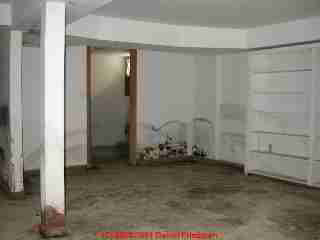
We need to move because I cannot live with this building-related sickness.
It is important to know what I'm dealing with before I go to management, because it seems to be such a severe structural issue, they may try to do something underhanded and cover it up.
We have a year lease and need to handle the situation in a way that will allow me get out from under this situation w/out our being taken advantage of and we are no expert in these matters.
Compromised autoimmune system increases health risks for tenant in moldy apartment
Also I have some sort of autoimmune condition(Lupus, MS they haven't pinned it down) we are no longer able to do what I went to school for. Our fine motor skills are compromised (and I have slight tremor).
Action Advice for Tenants in Moldy Apartments
On-site inspection is important: Keep in mind that anyone whose opinion you seek by telephone, email, or web "prospecting", even if s/he is very competent, is distant and can't see all of the site conditions. Therefore such advice can only be general, and we must keep in mind that there could be, in fact probably are, important observations that might change the assessment of an individual situation as well as the advice on steps to take.
If more than ten square feet of moldy material is found in a building or if mold returns after you have cleaned a small moldy surface, ask your landlord to fix the problem.
At TENANT LANDLORD MOLD DISPUTE we describe how a tenant or a third party might inspect a rental apartment or rental home, photo-document conditions found, and if necessary, collect mold test samples using an inexpensive procedure that can be processed by just about any environmental testing laboratory.
Advice to Renters when health complaints appear related to spending time in a building - where Mold is Visible or Suspected
Building-related illness symptoms often stop
or diminish quickly when the suffering person leaves that location. A simple subjective test which you have applied is the observation that you suffer health complaints soon on entry to the building and they stop when you've been out of the building.
Contents may be contaminated from a prior residence:
Of course if someone's apartment contents were mold-contaminated from a previous residence those complaints could still occur, so it's important to rule out that chance by recalling what reactions you had to your previous home.
Mold related illness symptoms don't always stop right away:
Finally, while some building-related or building-aggravated health complaints diminish or stop entirely on leaving that environment, other complaints may be slow to appear and also slow to diminish even after leaving the problem environment.
In fact high exposure to some materials such as allergens or mold can increase sensitivity to those particles in some individuals, making them later react to even low levels of such particles in a new environment.
Immediate Safety Advice for Tenants Complaining of Moldy Apartments
- Check for carbon monoxide - a potentially fatal problem:
First, some complaints I've heard, such as headache and nausea, have been traced to very dangerous exposure to carbon monoxide. So particularly if a building has gas-fired appliances or heat, it is important to rule out other non-mold but very dangerous conditions. Be sure that there is a working smoke detector and working carbon monoxide detector installed in appropriate locations such as in and outside of bedrooms.
See CARBON MONOXIDE - CO for details. - Warning to high-risk building occupants:
Second, people with severe asthma, compromised immune systems, elderly, infant, or otherwise at extra high risk of mold or other illnesses should be quicker to exit questionable areas and to avoid unnecessary exposure to respiratory or other irritants such as mold or moldy dust or demolition dust and debris.
See MOLD ACTION GUIDE - WHAT TO DO ABOUT MOLD. - If the building has been flooded:
be sure that safety and health are considered immediately as well as during and after cleanup work.
See FLOODS IN BUILDINGS-priorities. - Do not permit incompetent demolition work:
Before you and the building management have a clear idea of what work is needed and what health risks, if any, are involved, do not permit a work crew to come into the apartment and simply start demolition.
The risk is that mold-contaminated materials are indeed present and that without proper containment, the workers can make problems worse, exposing both apartment occupants and their belongings to moldy dust and debris. See
both MOLD CLEANUP GUIDE- HOW TO GET RID OF MOLD
and MOLD CLEARANCE: FOLLOWUP STEPS. - Check with your doctor:
to see if s/he has specific warnings or advice about your complaint, medical condition, and environment. - Be alert for other hazards
that may be more significant than mold, such as tripping and falling hazards, unsafe electrical wiring, or unsafe heating equipment.
Keep in mind that other indoor air quality problems might cause or contribute to building related health or respiratory complaints, such as poor ventilation, use of insecticides or other chemicals, presence of insects, particularly cockroaches, fleas, bedbugs, or more immediately dangerous hazards such as carbon monoxide from improperly functioning heating equipment or chimneys.
Health Risks for Tenants in Rental Apartments - Compromised immune system increases vulnerability to mold-related illness
The fact that a building occupant's immune system is compromised places that person at extra risk and means that s/he and the contents of their apartment need to be protected carefully.
People at extra risk of health problems if exposed to moldy dust and demolition debris include elderly, infants, immune-compromised, asthmatics, people suffering from COPD or other respiratory illness, and possibly others.
While chronic exposure to high levels of toxic or allergenic mold can make even some healthy people become sensitized as well, the people I just listed should be particularly careful about exposure.
See MOLD RELATED ILLNESS.
Advice About Possible Hidden Mold in Rental Apartments
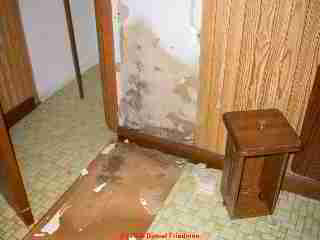
The mold that you *see* may not by any means be the whole problem, or even much of the problem; various species could be in building cavities and in the HVAC system.
Too often we find that "black mold" on building surfaces has received attention but hard-to-see Penicillium sp. or Aspergillus sp. (for example) remain in large reservoirs on building surfaces or in insulation.
One of the ways an expert finds the problem mold reservoir(s) in a building is to first understand what causes mold -
see MOLD CONTAMINATION CAUSES.
and second, where it is likely to be found - on what it grows.
See HIDDEN MOLD RISKS for RENTERS.)
Magic bullets: Also, "bleaching mold" or "fogging" or "encapsulating" mold is never a successful remedy for a moldy building.
The places where mold is growing must be found, moldy material removed, exposed surfaces cleaned, and the causes of mold growth corrected.
If the area of mold growth is large (more than 30 sq ft of contiguous moldy material) the work needs to proceed with special procedures to avoid spreading moldy dusty debris around.
See MOLD in BUILDINGS and
also HIDDEN MOLD.
Tenant-identified possible mold reservoirs
The tenant or building maintenance staff may have already identified apparent mold reservoirs or sources, and of course there could be other sources from other leaks or problems they haven't discovered:
Roof leaks - can have leaked into ceilings and walls; depending on what building materials used, they could be moldy with problem molds.
HVAC systems - If there is a common A/C duct system which has become mold contaminated, no amount of cleaning in your immediate apartment would be sufficient since it is possible that the whole system needs to be cleaned, or possibly some duct sections replaced, and the cause corrected.
Also it is common for A/C condensate or water from a chiller system to leak; water could have leaked into your closet ceiling and walls, also creating a problem mold reservoir.
Building insulation - often building insulation has become mold contaminated but looks "clean" to the naked eye. Few mold inspectors test this material, yet it is often discovered to be the principal problem mold reservoir in some building areas.
See INSULATION MOLD CONTAMINATION TEST.
Very often when we visit a site we find other leaks and mold sources that need to be addressed, so I wouldn't assume these are the full extent of what needs attention.
Advice When Building management is slow to address mold problems properly
Mold cleanup cost concerns:
Sometimes a building management is reluctant to face the expense and trouble of handling leaks and mold contamination correctly.
Correct response might require a (costly) thorough building survey, evaluation, diagnosis of problem areas and their causes and specification of the steps to remedy them, followed by performing of the work followed by clearance inspection and testing by someone not at all connected with the contractors performing the remediation. It would be rare for a building manager to have such an expert on full-time staff, so hiring an outside expert would be necessary.
Mold fear concerns:
Reluctance of building managers to address mold also comes from the wish to avoid alarming other tenants. In our experience this is always a mistaken notion, as tenants talk to one another anyway, and building-related illness frightens people - fear spreading faster than mold growth.
Accurate information and the assurance that tenant concerns are being handled competently is more effective than other less direct responses by building management.
True cost of improper mold remediation: Half-baked or amateur workmanship risks increasing the ultimate cost to the building management:
- Improper mold cleanup can increase indoor mold levels, making building occupants sick and/or by contaminating their belongings leading to the need for additional cleaning of contents and personal items.
- Improper mold remediation can lead to unnecessarily high costs of repeated attempts to clean up or remove problem mold or even repeated visits by building inspectors and "mold testers" until someone finally correctly diagnoses the causes of problem mold and finds the actual mold reservoirs, including moldy materials that may not have been obvious based on just a superficial inspection, an air test, swab, or culture mold sample.
- Risks of mold-related illness may spread to other building occupants or to future tenants in the same rental space if the cleanup is not properly performed.
- Improper mold causation diagnosis risks having to repeat the mold cleanup because the basic causes of mold growth have not been identified and corrected
In sum, it's least costly if mold remediation is performed properly in the first place.
What can a tenant do about a moldy apartment?
1. Notify in writing:
You should notify building management in writing of unhealthy unsafe conditions that need attention and that you are
unable to live in the apartment. If you are not certain of the presence of unsafe conditions in the rental apartment,
your letter should state your observations, complaints, concerns, and ask the building management to bring in the appropriate
professional to inspect, diagnose, and if needed, specify what repairs, cleaning, or remediation are needed.
Most building maintenance employees lack the training to recognize mold, conduct appropriate
mold inspection and testing, diagnose the extent and causes of problem mold, and evaluate the risk of mold
to rental tenants, nor specify the mold remediation procedures necessary.
Mold and Leak Reporting Advice for Renters
The U.S. EPA suggests that renters should report all plumbing leaks and moisture problems immediately to your building owner, manager, or superintendent.
In cases where persistent water problems are not addressed, you may want to contact local, state, or federal health or housing authorities.
Also see
HEALTH DEPARTMENT HELP for RENTERS
UNSAFE ENVIRONMENT, CAN'T LEAVE
2. Simple mold testing:
You might be successful in identifying some of the mold suspect material you see as problematic, and you might
collect a settled dust sample to see you can pick up indications of other problem molds or allergens.
However
identifying mold in an apartment, while it may convince building management to act, does not and cannot establish the
level of exposure that an individual has had to the mold found, nor does it assure that the mold identified is the only
or even the main hazard.
The prime use of tenant sampling in this case is to show management that there is at least some evidence of problem mold in the building
TEST KIT for DUST, MOLD, PARTICLES: INSTRUCTIONS contains sampling instructions you can follow. You should use another lab - not ours, as we no longer accept public environmental samples, but you can still follow our sampling procedures.
3. If building management responds:
If building management elects to make some effort to deal with the problem:
3.a. Proper dust control:
be sure that the work does not create demolition debris and mess which contaminates or further contaminates your
belongings, especially soft goods like curtains, carpets, bedcovers, which may then require cleaning, and worse,
upholstered furniture which might not be able to be cleaned adequately.
3.b. Possible contents cleaning:
if your possessions are already likely to be contaminated with moldy dust they should be cleaned before taking them
to a new home; soft goods can be laundered or dry cleaned; hard surfaces can simply be washed or wiped.
Moldy upholstered furniture is in question depending on how bad it is; surface dust can be vacuumed off of it; if upholstered furniture has been wet or has had mold growing on or in it is probably not salvageable without complete reupholstering from the frame up.
4. Should I Hire a Mold Expert
to examine my moldy apartment?
See MOLD / ENVIRONMENTAL EXPERT, HIRE ? for help in deciding when it is appropriate to bring in an expert. In general we do not advise tenants to face the trouble and expense of hiring an expert to inspect and test their landlord's building (or apartment and areas that affect the apartment) for mold.
But the information in that article suggests that when you are facing a serious health or economic risk, and if your landlord is not responding to your written and oral requests for help, hiring an independent expert may be useful.
Should I Call the health department about a moldy rental apartment?
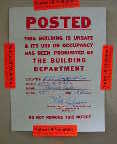
In some egregious cases tenants have taken their complaint to the local health department.
See HEALTH DEPARTMENT HELP for RENTERS
Renters in New York City who have a mold problem in their home and who have not been able to resolve it can contact the New York City Department of Health and Mental Hygiene:
Call 311, or visit nyc.gov/health. Select 'M' in 'Health Topics A to Z' and click on 'Mold'.
If you live in another city or town, contact your local health department for advice. But beware; the staff at some health departments may not be educated about the common causes, extent, and potential health complaints often associated with mold exposure.
If there is a serious and obvious problem with mold or other health concerns in a rental apartment the health department may condemn the property and require the owners to act. In our opinion this rather drastic step may be appropriate in dire circumstances. It will also be likely to end any cooperation between landlord and tenant.
The more you know about proper procedures to find and clean up moldy buildings the better you can assure that your situation is handled properly. The articles at these links might be helpful:
When to Hire a Mold Professional -
see MOLD / ENVIRONMENTAL EXPERT, HIRE ?
When is mold a problem in buildings? What should be done about it? Find expert field and lab testing, inspection, remediation advice, but ... avoid "fear of mold" and bogus advice which can both cost you and yet may not really address the problem effectively. Our interest is in providing expert service to our clients, protecting not only their health but their wallets
Mold Contamination Case Histories
At our Mold Blog MOLD CENTRAL: indoor air quality investigation case histories, I post summaries of field and lab toxic or allergenic mold and other indoor air quality investigations. I omit private information.
I describe observations, procedures, and findings helpful to readers who are trying to remedy their own mold, allergenic, carbon monoxide, odor, or other indoor air and related health concerns in their indoor environment.
...
Reader Comments, Questions & Answers About The Article Above
Below you will find questions and answers previously posted on this page at its page bottom reader comment box.
Reader Q&A - also see RECOMMENDED ARTICLES & FAQs
Question: Our landlord agrees our apartment needs gut demolition & cleaning but we have not moved-out
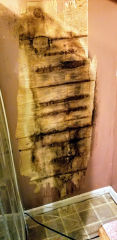 So June of last year my fiancé found a house for rent through someone she worked with and we decided to go for it due to the large yard because we have multiple pets.
So June of last year my fiancé found a house for rent through someone she worked with and we decided to go for it due to the large yard because we have multiple pets.
Bear in mind we live in Arkansas, the magical land of nonexistent tenant rights. Upon moving in we both started noticing seemingly random symptoms (skin issues, headaches, sinus problems, fatigue, etc.)
When we moved in we were informed of a home in one of the kitchen cabinets that was "caused by rain" but didn't think much of it.
We also had a problem with roaches around the fridge and found a sizeable hole behind the refrigerator which I've attached a photo as well. Obviously the symptoms only increased in severity and only after an exhaustive online search did I attribute our symptoms to fungal infection.
Prescription medication seemed to help at first but it all came back once we ceased the medication.
So in September I stumbled across Inspectapedia and finally made the connection that mold had to be the cause for our problems.
We got a mold test and the results were shocking to say the least.
I've attached a picture of the results about the first test and the second test the second time we let sit on the living-room table for the allotted hour and then sealed it exactly is the instructions directed.
When we brought this to our landlords attention they didn't seem all that shocked by the information in fact they seemed like they might have already known about it and didn't show up until November to attempt any repair to the house. One night I got the bright idea to look at our crawlspace just to see and I've attached a video of what I found.
They showed up pretty quickly after receiving the video and supposedly pumped out the water and fixed the problem according to them. When I confronted them about what was to be done about the existing mold they replied with this text message: "Take this months rent and find somewhere else to live ASAP, Since it is causing physical symptoms.
To get rid of the mold 100%, we will have to gut the house and no one needs to be living there. We will take your deposit and prorate this months rent for however long it takes you to move."
This is two weeks before Christmas by the way. So we paid our rent because there aren't really a whole lot of places to move to at the moment we've been looking trust me.
We even had a mold remediation expert come in and evaluate the house and said we'd have to move out and they will have to gut the house which is interesting because that's what they said before we even had the expert come in to look at it.
We're at our wits end and don't know what to do stop any advice would be greatly appreciated. - Anonymous by private email 2020/01/19
Reply: move out and clean your posessions
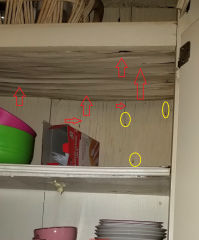 With the apology that I know perfectly well that it's easier to give advice than to take it, it sounds to me as if
With the apology that I know perfectly well that it's easier to give advice than to take it, it sounds to me as if
- Move out of the very-moldy environment promptly.
Everyone who has looked at your situation, per your own report, has said you ought to move out of what appears to be a seriously-contaminated moldy home.
It sounds to me as if you should take that advice very quickly.
While individual vulnerability to mold-related illness varies enormously by personal health condition (aged, asthmatic, allergic, elderly, infant, immune-impaired are at greater risk), even a healthy person can become sensitized to mold (or to allergens of various sorts) following either prolonged or even a single acute exposure.
In other words every day you stay in a very moldy home increases your risk of serious, even potentially long-lasting mold -related illness.
Watch out: That does NOT mean run screaming out of the house in panic. Panic is bad for both your health and your wallet. But lingering, rationalizing, waiting are a mistake.
- Clean Your Stuff before moving it into a new home.
Troublesome but true, depending on just how moldy is your present environment, moving your possessions out of it into a new home risks importing at the very least quite a bit of moldy dust. You'll want to clean everything: washing hard surfaced items, laundering, dry cleaning.
If you find visible mold growing on upholstered furniture it's usually not economical to even try to clean it (which won't be successful anyway). - A wet moldy crawl area is often a mold palace that can send various genera / species of mold, ranging from allergenic to pathogenic to toxic, up into the occupied space and of course the dampness moving upstairs also can invite mold growth in building cavities
Other building leaks and mold: In addition your photos show that there have been chronic leaks from higher in the home, such as from roof or wall leaks.
Delaminating plywood wall paneling and shelving with stains (marked in red and yellow on one of your photos) from water running down those surfaces are possible but not likely to be due to the wet crawl space.
There are likely to be other extensive reservoirs of mold in the building . - Mold tests, including settlement plates or culture plates are fundamentally and very inaccurate in characterizing what mold contamination is actually present in a building.
There is NO good correlation between your test and what mold genera species are actually present or dominant or most-harmful in the building.
ACCURACY of MOLD TESTS - all types of mold tests is a place to start if you need to know more, but most-likely you don't - More pertinent advice for renters is
at RENTERS & TENANTS ADVICE for UNSAFE or UNHEALTHY HOME but it sounds to me as if your landlord is
- taking the mold problem seriously and knows that such extensive work is needed that you cannot safely be in the home
or - wants to get rid of a worrisome tenant without incurring avoidable liability (on occasion I find landlords covering over mold or other hazards and simply re-renting)
On 2019-01-28 by (mod) -
Or during or before completion
On 2019-01-27 by Charles
Should a certified industrial hygienist be informed of any immune-compromising condition of an apartment dweller before inspection?
Question:
(Apr 12, 2016) MT said:
I rent an apartment in Tampa, FL and have recently located what I believe to be mold in the A/C handler/Unit. I have had a host of health issues since moving in last year including sinus/allergies/migraines, etc. I even have had to go to the emergency room a couple of times (1st in my life).
I have been taking some preemptive strikes to help keep the dust/allergens, etc clear and went to replace the filter in the unit and happen to notice what I believe to be mold. I notified the property manager right away and a maintenance person was dispatched. The maintenance person took two seconds to "look" at it and said, it's not mold.
Then took my little zip lock of samples and left. I am left confused and concerned. Not sure what next steps should be.... any ideas?
This question/comment was posted originally
at HOW TO CONTACT InspectApedia.com
Reply:
I'd take a look at RENTERS & TENANTS ADVICE for UNSAFE or UNHEALTHY HOME or from elsewhere at InspectApedia.com by using the search box just above. That will give you so9me suggestions on how to proceed.
...
Continue reading at HEALTH DEPARTMENT HELP for RENTERS or select a topic from the closely-related articles below, or see the complete ARTICLE INDEX.
Or see RENTAL UNIT MOLD & IAQ FAQ - questions & answers about moldy rental homes, posted originally at the end of this page
Or see these
Articles on Tenants Guide to Mold
- RENTERS & TENANTS ADVICE for UNSAFE or UNHEALTHY HOME
- HEALTH DEPARTMENT HELP for RENTERS
- HIDDEN MOLD RISKS for RENTERS
- HOUSING, EMERGENCY & TEMPORARY
- LEGAL AID ATTORNEY HELP SOURCES
- MOLD ACTION ADVICE for RENTERS
- MOLD CONTAMINATION CAUSES
- MOLD HEALTH RISKS for TENANTS
- MOLD SAFETY ADVICE for TENANTS
- MOLD ADVICE for BUILDING MANAGERS
- TENANT HELP for MOLDY RENTAL
- TENANT LANDLORD MOLD DISPUTE
- UNSAFE ENVIRONMENT, CAN'T LEAVE - what if you have to continue to live in a moldy apartment or rental home?
Suggested citation for this web page
RENTERS & TENANTS ADVICE for UNSAFE or UNHEALTHY HOME at InspectApedia.com - online encyclopedia of building & environmental inspection, testing, diagnosis, repair, & problem prevention advice.
Or see this
INDEX to RELATED ARTICLES: ARTICLE INDEX to MOLD CONTAMINATION & REMEDIATION
Or use the SEARCH BOX found below to Ask a Question or Search InspectApedia
Ask a Question or Search InspectApedia
Questions & answers or comments about handling indoor hazards, air quality, contaminants, or mold problems in rental homes, apartments, mobile homes, doublewides
Try the search box just below, or if you prefer, post a question or comment in the Comments box below and we will respond promptly.
Search the InspectApedia website
Note: appearance of your Comment below may be delayed: if your comment contains an image, photograph, web link, or text that looks to the software as if it might be a web link, your posting will appear after it has been approved by a moderator. Apologies for the delay.
Only one image can be added per comment but you can post as many comments, and therefore images, as you like.
You will not receive a notification when a response to your question has been posted.
Please bookmark this page to make it easy for you to check back for our response.
IF above you see "Comment Form is loading comments..." then COMMENT BOX - countable.ca / bawkbox.com IS NOT WORKING.
In any case you are welcome to send an email directly to us at InspectApedia.com at editor@inspectApedia.com
We'll reply to you directly. Please help us help you by noting, in your email, the URL of the InspectApedia page where you wanted to comment.
Citations & References
In addition to any citations in the article above, a full list is available on request.
- [1] "A Brief Guide to Mold, Moisture, and Your Home", U.S. Environmental Protection Agency US EPA - includes basic advice for building owners, occupants, and mold cleanup operations. See http://www.epa.gov/mold/moldguide.html
- [2] Find your state health department contacts at www.epa.gov/iaq/whereyoulive.html (click on your state)
- [3] Safety Solutions, Emergency Response Equipment and Training, Safety Solutions Incorporated Main Warehouse 3457 High Ridge Road Boynton Beach, Florida 33426, Tel: 866-248-1050, web search 5/31/12. original source: Website: http://www.safetysolutions.us/product_p/hmss-1.htm
- [4] Smart Strip, Tel: 561-738-7066, web search 5/31/12. original source: Website: www.smart-strip.com [Website appears non-functional 5/31/12]
- [5] Safety Solutions Incorporated 4672 Bucida Road Boynton Beach, Florida 33436, Mike Reimer, Tel: 866-248-1050, web search 5/31/12. original source: Website: http://www.safetysolutions.us/
- [6] Cornell University Law School, Legal Information Institute (LII), "Hotels and Restaurants, Hotel and restaurant law, an overview", retrieved 6/8/2013, original source: http://www.law.cornell.edu/wex/hotels_and_restaurants
- [7] New York State Department of Health, "Part 7, Subpart 7-1 Temporary Residences (Hotels, Motels and Cabin Colonies)", Retrieved 6/8/2013, original source: http://www.health.ny.gov/regulations/nycrr/title_10/part_7/subpart_7-1.htm#s714
To ensure accuracy and for evidentiary purposes, reference should be made to the Official Compilation of the Rules and Regulations of the State of New York, available from West Publishing at 1-800-344-5009. - Our recommended books about building & mechanical systems design, inspection, problem diagnosis, and repair, and about indoor environment and IAQ testing, diagnosis, and cleanup are at the InspectAPedia Bookstore. Also see our Book Reviews - InspectAPedia.
- Kansas State University, department of plant pathology, extension plant pathology web page on wheat rust fungus: see http://www.oznet.ksu.edu/path-ext/factSheets/Wheat/Wheat%20Leaf%20Rust.asp
- A BRIEF GUIDE to MOLD, MOISTURE, and YOUR HOME, [PDF] U.S. Environmental Protection Agency US EPA - includes basic advice for building owners, occupants, and mold cleanup operations. See http://www.epa.gov/mold/moldguide.htm
- US EPA - UNA BREVA GUIA a MOHO / HONGO - en Espanol
- US EPA - MOLD REMEDIATION in SCHOOLS & COMMERCIAL BUILDINGS - US EPA
- "IgG Food Allergy Testing by ELISA/EIA, What do they really tell us?" Sheryl B. Miller, MT (ASCP), PhD, Clinical Laboratory Director, Bastyr University Natural Health Clinic - ELISA testing accuracy: Here is an example of Miller's critique of ELISA - www.betterhealthusa.com/public/282.cfm - Townsend Letter for Doctors and Patients
The critique included in that article raises compelling questions about IgG testing assays, which prompts our interest in actually screening for the presence of high levels of particles that could carry allergens - dog dander or cat dander in the case at hand.
- www.tldp.com/issue/174/IgG%20Food%20Allergy.html - contains similar criticism in another venue but interestingly by the same author, Sheryl Miller. Sheryl Miller, MT (ASCP), PhD, is an Immunologist and Associate Professor of Basic and Medical Sciences at Bastyr University in Bothell, Washington. She is also the Laboratory Director of the Bastyr Natural Health Clinic Laboratory. - Allergens: Testing for the level of exposure to animal allergens is discussed at http://www.animalhealthchannel.com/animalallergy/diagnosis.shtml (lab animal exposure study is interesting because it involves a higher exposure level in some cases
- Allergens: WebMD discusses allergy tests for humans at webmd.com/allergies/allergy-tests
- Atlas of Clinical Fungi, 2nd Ed., GS deHoog, J Guarro, J Gene, & MJ Figueras, Centraalbureau voor Schimmelcultures, Universitat Rovira I Virgili, 2000, ISBN 90-70351-43-9
- Fifth Kingdom, Bryce Kendrick, ISBN13: 9781585100224, - we recommend the CD-ROM version of this book. This 3rd/edition is a compact but comprehensive encyclopedia of all things mycological. Every aspect of the fungi, from aflatoxin to zppspores, with an accessible blend of verve and wit. The 24 chapters are filled with up-to-date information of classification, yeast, lichens, spore dispersal, allergies, ecology, genetics, plant pathology, predatory fungi, biological control, mutualistic symbioses with animals and plants, fungi as food, food spoilage and mycotoxins.
- Fungi, Identifying Filamentous, A Clinical Laboratory Handbook, Guy St-Germain, Richard Summerbell, Star Publishing, 1996, ISBN 0-89863-177-7 (English)
- US EPA: Mold Remediation in Schools and Commercial Building [Copy on file at /sickhouse/EPA_Mold_Remediation_in_Schools.pdf ] - US EPA
- In addition to citations & references found in this article, see the research citations given at the end of the related articles found at our suggested
CONTINUE READING or RECOMMENDED ARTICLES.
- Carson, Dunlop & Associates Ltd., 120 Carlton Street Suite 407, Toronto ON M5A 4K2. Tel: (416) 964-9415 1-800-268-7070 Email: info@carsondunlop.com. Alan Carson is a past president of ASHI, the American Society of Home Inspectors.
Thanks to Alan Carson and Bob Dunlop, for permission for InspectAPedia to use text excerpts from The HOME REFERENCE BOOK - the Encyclopedia of Homes and to use illustrations from The ILLUSTRATED HOME .
Carson Dunlop Associates provides extensive home inspection education and report writing material. In gratitude we provide links to tsome Carson Dunlop Associates products and services.



